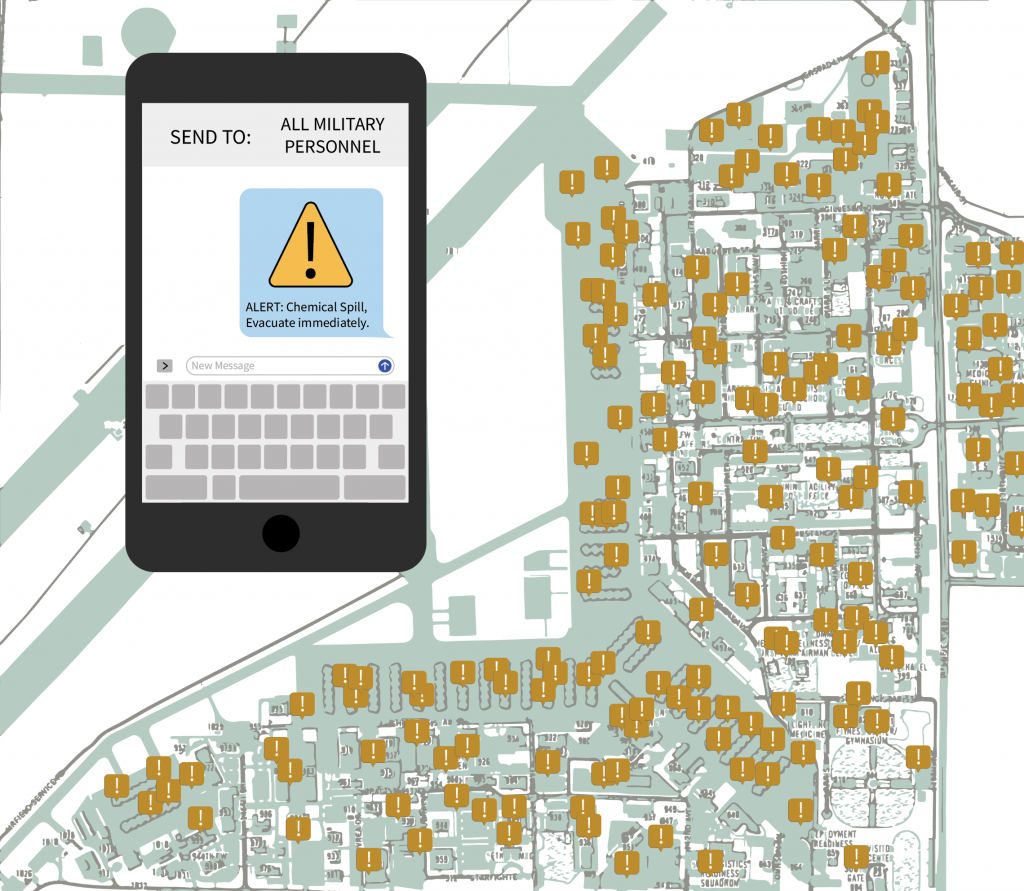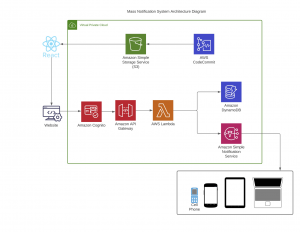Flexible and Customizable Mass Notification Alerts for Luke Air Force Base

Overview
The 56th Maintenance Group (56 MXG) located at Luke Air Force Base (Luke AFB) and operated by the United States Air Force builds the future of air power by executing world class flying operations, providing elite instruction, and cultivating the air power community for the United States. To continue to drive this mission, the 56 MXG collaborated with the National Security Innovation Network (NSIN) and the Cal Poly Digital Transformation Hub (DxHub) powered by Amazon Web Services (AWS) to develop a cloud based solution to provide a dynamic mass notification capability to ensure that critical and targeted messaging gets through to base personnel as quickly as possible.
Problem
 With over 3,000 active military personnel housed at the base, the 56 MXG as looking for a modern, flexible, scalable, and customizable mass notification system to alert personnel as directed by base command via text message. 56 MXG also needed lower ranking commanders to have the ability to send targeted notifications to their subordinates while avoiding sending unnecessary and irrelevant messages to personnel outside of their command. In the past, base administrators have been required to manually enter new and existing personnel contact information from a spreadsheet when an emergency or semi-emergency event required mass notification and had limits on how many contacts could be pushed into the system at one time.
With over 3,000 active military personnel housed at the base, the 56 MXG as looking for a modern, flexible, scalable, and customizable mass notification system to alert personnel as directed by base command via text message. 56 MXG also needed lower ranking commanders to have the ability to send targeted notifications to their subordinates while avoiding sending unnecessary and irrelevant messages to personnel outside of their command. In the past, base administrators have been required to manually enter new and existing personnel contact information from a spreadsheet when an emergency or semi-emergency event required mass notification and had limits on how many contacts could be pushed into the system at one time.
Innovation in Action
 During NSIN’S 2021 summer design sprint, Luke AFB’s 56 MXG collaborated with an NSIN X-Force ‘Fellow’ team and the DxHub powered by AWS to design a new base-wide mass notification system and user experience for administrators and base personnel receiving alerts. The teams co-developed and refined the solution called ‘Project Hermes’.
Project Hermes is a new flexible and scalable text message based notification system that can issue broad or targeted notifications to authenticated military personnel. It can issue notifications to all 3,000 plus credentialed personnel by base command in just a few clicks and can scale to thousands more if needed while maintaining a constantly updated roster of verified recipients. Conversely, a commander can issue text notifications to a subgroup of their subordinates in the same manner. Examples of broad based notification types include localized emergencies like chemical spills, security instances, and weather alerts. Targeted notifications from commanders directly to their subordinates may include short notice deployment orders and other subgroup specific emergency orders. Project Hermes ensures that actionable notifications get to the right people at the right time.
The X-Force ‘Fellow’ team worked directly on a day-to-day basis with the 56 MXG problem sponsor to understand the requirements and user perspective while working with the DxHub to define and refine the user experience and technical cloud architecture needed to bring the solution to life.
“Our problem sponsors Master Sergeant Joseph Anger and Technical Sergeant Brady Flynn were extremely cooperative and made our experience amazing during this design sprint. Their leadership and drive for innovation gave us the opportunity to explore new ways of creating a solution and have continuously supported us each step of the way.” Said Luis P., Summer X-Force Fellow and current DxHub student employee.
During NSIN’S 2021 summer design sprint, Luke AFB’s 56 MXG collaborated with an NSIN X-Force ‘Fellow’ team and the DxHub powered by AWS to design a new base-wide mass notification system and user experience for administrators and base personnel receiving alerts. The teams co-developed and refined the solution called ‘Project Hermes’.
Project Hermes is a new flexible and scalable text message based notification system that can issue broad or targeted notifications to authenticated military personnel. It can issue notifications to all 3,000 plus credentialed personnel by base command in just a few clicks and can scale to thousands more if needed while maintaining a constantly updated roster of verified recipients. Conversely, a commander can issue text notifications to a subgroup of their subordinates in the same manner. Examples of broad based notification types include localized emergencies like chemical spills, security instances, and weather alerts. Targeted notifications from commanders directly to their subordinates may include short notice deployment orders and other subgroup specific emergency orders. Project Hermes ensures that actionable notifications get to the right people at the right time.
The X-Force ‘Fellow’ team worked directly on a day-to-day basis with the 56 MXG problem sponsor to understand the requirements and user perspective while working with the DxHub to define and refine the user experience and technical cloud architecture needed to bring the solution to life.
“Our problem sponsors Master Sergeant Joseph Anger and Technical Sergeant Brady Flynn were extremely cooperative and made our experience amazing during this design sprint. Their leadership and drive for innovation gave us the opportunity to explore new ways of creating a solution and have continuously supported us each step of the way.” Said Luis P., Summer X-Force Fellow and current DxHub student employee. Solution
 With the goal of digitalizing the recall roster system of Luke AFB. The X-Force ‘Fellow’ team created a web interface for commanders to send messages to subordinates. Using React.js, the team was able to provide a simple and easy-to-use interface that commanders could use to send messages to subordinates. This web application is hosted using AWS Simple Storage Service allowing the public to view and access the user dashboard. To ensure security, authentication is used through AWS Cognito to create a simple user-sign in access control system. Using AWS API Gateway, the content of the message is securely sent to the recipients instantaneously. AWS Lambda automatically processes the contents and conditions of the message in order to determine the correct group of recipients. The message is then sent through AWS Simple Notification Service using the Topic and Subscriber system as a way to categorize recipients into specific sets within the hierarchy. All data that needs to be stored is categorized and stored for use in NoSQL database tables under AWS DynamoDB. All of these services make up a cohesive serverless architecture that gives a commander the ability to send a message to a specific set of recipients under their leadership.
With the goal of digitalizing the recall roster system of Luke AFB. The X-Force ‘Fellow’ team created a web interface for commanders to send messages to subordinates. Using React.js, the team was able to provide a simple and easy-to-use interface that commanders could use to send messages to subordinates. This web application is hosted using AWS Simple Storage Service allowing the public to view and access the user dashboard. To ensure security, authentication is used through AWS Cognito to create a simple user-sign in access control system. Using AWS API Gateway, the content of the message is securely sent to the recipients instantaneously. AWS Lambda automatically processes the contents and conditions of the message in order to determine the correct group of recipients. The message is then sent through AWS Simple Notification Service using the Topic and Subscriber system as a way to categorize recipients into specific sets within the hierarchy. All data that needs to be stored is categorized and stored for use in NoSQL database tables under AWS DynamoDB. All of these services make up a cohesive serverless architecture that gives a commander the ability to send a message to a specific set of recipients under their leadership. Supporting Documents
| Fictitious Press Release & Frequently Asked Questions | During the Innovation Workshop, a fictional Press Release and nonfictional Frequently Asked Questions are drafted. This is a tool that is used as a vision document to define the solution and why it matters. |
| Architecture Diagram | A diagram that describes the technical components needed to implement the solution. |
| Prototype Video | An overview of the prototype and a brief demo the solution. |
About the DxHub
Cal Poly’s Digital Transformation Hub (DxHub) was one of the earliest collaborations between Amazon Web Services (AWS) and an educational institution focused on innovation and digital transformation. While providing students with real-world learning experiences, the DxHub applies proven innovation methodologies in combination with the deep subject matter expertise of the public sector and the technical expertise of AWS to solve challenging problems in ways not contemplated before. For more information, visit dxhub.calpoly.edu.
